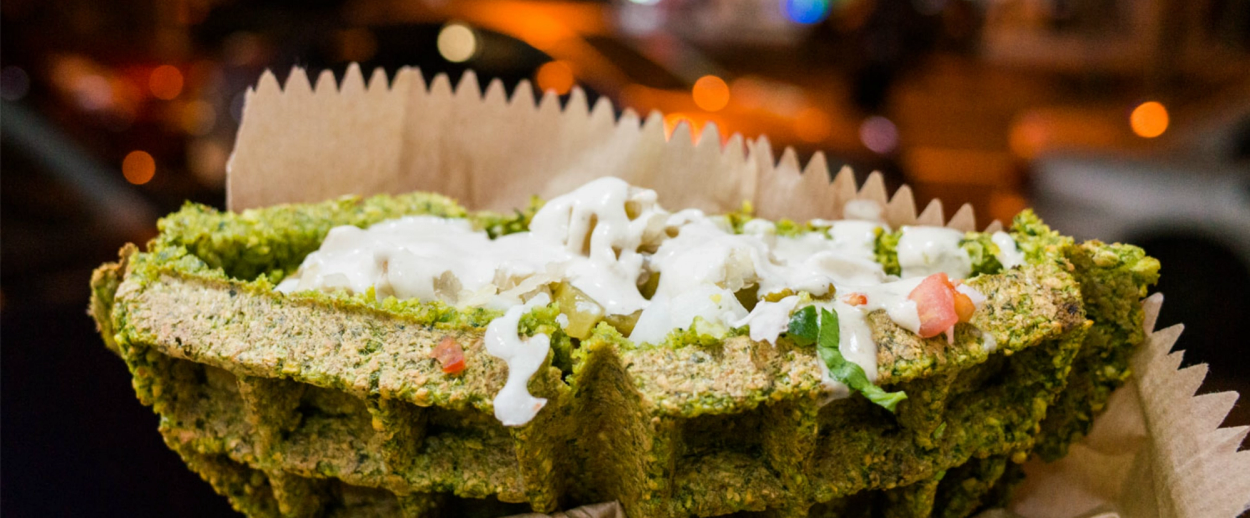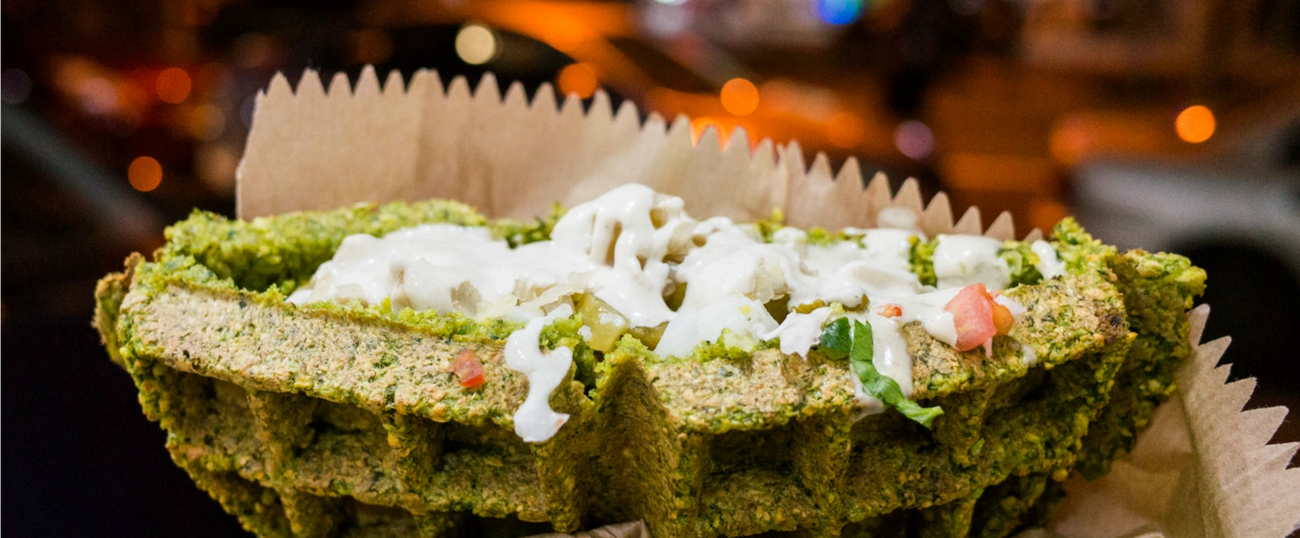The Belgian Falafel Waffle
An edible miracle of modern science takes off in Rishon LeZion




Falafel, the Middle Eastern fast food staple, is one of the food staples most closely identified with Israeli cuisine. Crisp and speckled with herbs, chickpea-rich falafel balls are Egypt’s contribution to the Levantine street food culture, usually nestled inside fluffy pitas. With time, as Israel’s culinary scene evolved and started playing up its key assets, falafel has found itself on several fine-dining plates, as a placeholder for new flavors; modern Tel Avivian restaurants now infuse it with eggplant, beets and other variations, and serve it on ‘beds’ of yogurt and sauces. A very un-kosher shrimp falafel is a thing as well; just ask star chef Marcus Samuelsson, whose 2014 book Marcus Off Duty: The Recipes I Cook at Home includes a recipe for one.
But for all its adventurous reincarnations, falafel always stayed true to its form—that is, it has remained reliably round and portioned in the form of familiar, delectable balls. Until now, that is. A couple of months ago, a sensation stormed the Israeli food scene, blazing through social media and making several TV appearances. Falafel Belgi (Belgian falafel), out of Rishon LeZion, a sprawling city near Tel Aviv, is a new eatery turning the tables on the traditional falafel concept. Instead of treating falafel’s familiar chickpea mash as the filling, the folks at Falafel Belgi pour falafel batter into a Belgian waffle mold and turn it into the vehicle for salads, pickles, and condiments: tahini, spicy pesto, and lemony spicy carrot salad, to name a few.
Behind the invention are Almog and Tali Shem Tov, a couple that already owns a business on the same central street, a tattoo and piercing parlor. Without any formal culinary training, the two quickly became local celebrities. The Belgian falafel, they say, was born both out of creativity and necessity. The couple, avid vegans and healthy eaters, felt like their deep love for the popular Israeli dish was tainted by the equally deep frying process and the copious amounts of oil falafel is inevitably fried in. With the press-made Belgian waffle falafel, however, deep frying isn’t an issue, and no oil is involved. And for better or for worse, the creation is also completely gluten-free. “We took a very popular dish, that statistically succeeds everywhere in the world, and made it into a superfood, Almog Shem Tov says. The waffle? “I dreamt it up,” he explains. “When I have an idea, I just must try it. So we did.” The final result—a falafel waffle sturdy enough to contain the semi-liquid tahini and juicy salads—wasn’t easy to achieve. “It took us almost a year,“ Shem Tov says. “We tried all sorts of Belgian waffle presses from China to Portugal and did endless tries with our mix. The mix we arrived it is rich in nutrients, protein, and vitamins.” All thanks to a blend of chickpeas, spices, and herbs.
In just two shorts months, Falafel Belgi has become a hit. Shem Tov says that he has received franchise offers from Australia and Los Angeles. Clients are lining up, and two haven’t yet had the time to put up a menu, due to the constant stream of customers. Currently, the couple are working on going nationwide, with the next location opening soon in Tel Aviv. The Israeli eaters are known for their love of gimmicks and novelty, always ready to embrace a bold new trend. Indeed, Shem Tov says, the first reaction is disbelief. “People are very surprised, and keep asking where’s the pita, what did we do with it,” he says. But after the initial shock, they become regulars. “People stop seeing it as a gimmick and treat it just as better food,” For Shem Tov, despite the very trendy mash of genres (cronut! tacro!) the Belgian falafel is playing into, it’s really the health angle that makes the new dish sustainable. “It would’ve been the right timing, no matter who invented it,” he says. “People are tired of deep frying and oil, and seek healthy, nutritious foods with familiar flavors.” And the fact the dish looks cool on social media? Well, that never hurts.
Flora Tsapovsky is a San Francisco-based food and culture writer.